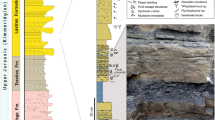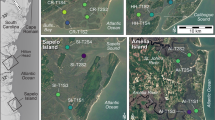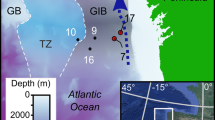Abstract
Sediment mounds, composed of faecal material from megafaunal deposit feeders1,2, occur in virtually all deep-sea environments, forming the dominant decimetre-scale topography on the ocean floor3,4. Mounds are often zones of deep, convective bioturbation1,2, and their formation is thought to disturb infaunal benthos5,6. We are studying mounds in the deep sea to evaluate rates and patterns of megafaunal sediment mixing, and to assess the disturbance effects of mound building on the infaunal community, with the goal of using mounds to investigate natural processes of succession at the deep-sea floor7. Our results indicate that sediment turnover associated with mound building by echiuran worms can be very rapid, and that bathyal infauna can respond quickly to this type of disturbance. These findings suggest that spatially rare but dynamic elements in the sediment fabric, such as mounds, may be important in controlling microstratigraphy, chemical diagenesis and community structure at the deep-sea floor.
This is a preview of subscription content, access via your institution
Access options
Subscribe to this journal
Receive 51 print issues and online access
$199.00 per year
only $3.90 per issue
Buy this article
- Purchase on Springer Link
- Instant access to full article PDF
Prices may be subject to local taxes which are calculated during checkout
Similar content being viewed by others
References
Rhoads, D. C. Oceanogr. mar. Biol. A. Rev. 12, 263–300 (1974).
Carney, R. S. in Principles of Benthic Marine Paleoecology(ed. Boucot, A. J.) 357–400 (Academic, New York, 1981).
Heezen, B. C. & Hollister, C. D. The Face of the Deep (Oxford University Press, 1971).
Young, D. K., Jahn, W. H., Richardson, M. D. & Lohanick, A. W. Mar. Geol. 68, 269–301 (1985).
Smith, C. R. Deep Sea Res. 32, 417–442 (1985).
Smith, C. R. J. mar. Res. 44 (1985).
Smith, C. R. in Proc. 19th Eur. mar. Biol. Symp. (ed. Gibbs, P. E.) 183–190 (Cambridge University Press, 1985).
Smith, C. R. & Hamilton, S. C. Deep Sea Res. 30, 907–928 (1983).
Stephen, A. C. & Edmonds, S. J. The Phyla Spiuncula and Echiura (British Museum, London, 1972).
Jaccarini, V. & Schembri, P. J. J. exp. mar. Biol. Ecol. 28, 163–181 (1977).
Risk, M. J. Science 180, 1285–1287 (1973).
Ohta, S. Deep Sea Res. 31, 1415–1432 (1984).
Schwalbach, J. R. & Gorsline, D. R. J. geophys. Res. 55, 829–842 (1985).
Guinasso, N. L. & Schink, D. R. J. geophys. Res. 80, 3032–3043 (1975).
Aller, R. C. & Cochran, J. K. Earth planet. Sci. Lett. 29, 37–50 (1976).
DeMaster, D. J., McKee, B. A., Nittrouer, C. A., Brewster, D. C. & Biscaye, P. E. Mar. Geol. 66, 133–148 (1985).
Tudhope, A. W. & Scoffin, T. P. J. sedim. Petrol. 54, 1091–1096 (1984).
Hessler, R. R. & Smithey, W. Sandia Rep. (in the press).
Aller, R. C. in Animal-Sediment Relations (eds McCall, P. L. & Tevesz, M. J. S.) 53–102 (Plenum, New York, 1982).
Brenchley, G. A. J. mar. Res. 39, 767–790 (1981).
Turk, T. R. & Risk, M. J. Can. J. Fish. aquat. Sci. 38, 642–648 (1981).
Jumars, P. A. Mar. Min. 5, 213–229 (1981).
Gallucci, V. F. & Kawaratani, R. K. J. Fish. Res. Bd Can. 32, 1637–1640 (1975).
Nichols, J. A., Rowe, G. T., Clifford, C. H. & Young, R. A. J. sedim. Petrol. 48, 419–425 (1978).
Grassle, J. F. Nature 265, 518–619 (1977).
Desbruyeres, D., Bervas, J. Y. & Khripounoff, A. Oceanol. Acta 3, 285–291 (1980).
Levin, L. A. & Smith, C. R. Deep Sea Res. 31, 1277–1285 (1984).
Author information
Authors and Affiliations
Rights and permissions
About this article
Cite this article
Smith, C., Jumars, P. & DeMaster, D. In situ studies of megafaunal mounds indicate rapid sediment turnover and community response at the deep-sea floor. Nature 323, 251–253 (1986). https://doi.org/10.1038/323251a0
Received:
Accepted:
Issue Date:
DOI: https://doi.org/10.1038/323251a0
This article is cited by
-
Mystery tubes coiled around deep-water tropical gorgonians: fecampiid cocoons (Platyhelminthes: Fecampiida) resembling Solenogastres (Mollusca)
Systematic Parasitology (2007)
-
Impact of irrigation on oxygen flux into the sediment: intermittent pumping by Callianassa subterranea and ?piston-pumping? by Lanice conchilega
Marine Biology (1995)
-
Photographic observations of deep-sea infaunal ophiuroids in Suruga Bay, central Japan: an application of a free-fall system of time-lapse cameras and current meters
Journal of the Oceanographical Society of Japan (1990)
-
Direct measurement of the diffusive sublayer at the deep sea floor using oxygen microelectrodes
Nature (1989)
-
Benthic-pelagic coupling in a deep-sea benthic community
Nature (1989)
Comments
By submitting a comment you agree to abide by our Terms and Community Guidelines. If you find something abusive or that does not comply with our terms or guidelines please flag it as inappropriate.



